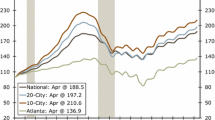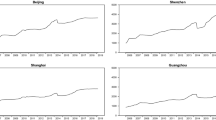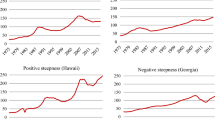Abstract
We examine the time-series relationship between house prices in Los Angeles, Las Vegas, and Phoenix. First, temporal Granger causality tests reveal that Los Angeles house prices cause house prices in Las Vegas (directly) and Phoenix (indirectly). In addition, Las Vegas house prices cause house prices in Phoenix. Los Angeles house prices prove exogenous in a temporal sense and Phoenix house prices do not cause prices in the other two markets. Second, we calculate out-of-sample forecasts in each market, using various vector autoregressive and vector error-correction models, as well as Bayesian, spatial, and causality versions of these models with various priors. Different specifications provide superior forecasts in the different cities.
Similar content being viewed by others
References
Bikker JA (1993) Interdependence between the Netherlands and Germany: forecasting with VAR model. de Economist 141: 43–69
Brookings Institution (2008) Mountain Megas: America’s Newest metropolitan places and a federal partnership to help them prosper. Metropolitan Policy Program. http://www.brookings.edu/~/media/Files/rc/reports/2008/0720_intermountain_west_sarzynski/IMW_full_report.pdf
Clapp JM, Tirtiroglu D (1994) Positive feedback trading and diffusion of asset price changes: evidence from housing transactions. J Econ Behav Organ 24: 337–355
Dickey DA, Fuller WA (1979) Distribution for the estimates for autoregressive time series with a unit root. J Am Stat Assoc 74: 427–431
Doan TA, Litterman RB, Sims CA (1984) Forecasting and conditional projections using realistic prior distributions. Econom Rev 3(1): 1–100
Dua P, Ray SC (1995) A BVAR model for the Connecticut economy. J Forecast 14(3): 167–180
Elliott G, Rothenberg TJ, Stock JH (1996) Efficient tests for an autoregressive unit root. Econometrica 64: 813–836
Fackler JS, McMillin WD (1984) Monetary vs. credit aggregates: an evaluation of monetary policy targets. South Econ J 50: 711–723
Gupta R (2006) Forecasting the South African economy with VARs and VECMs. S Afr J Econ 74(4): 611–628
Gupta R, Miller SM (2010) The time-series properties on housing prices: a case study of the Southern California market. J Real Estate Finance Econ (in press)
Gupta R, Sichei MM (2006) A BVAR model for the South African economy. S Afr J Econ 74(3): 391–409
Hafer RW, Sheehan RG (1989) The sensitivity of VAR forecasts to alternative lag structures. Int J Forecast 5: 399–408
Hamilton JD (1994) Time series analysis, 2nd edn. Princeton University Press, Princeton
Hoehn JG (1984) A regional economic forecasting procedure applied to Texas. Federal Reserve Bank of Cleveland, Working paper 8402
Hoehn JG, Gruben WC, Fomby TB (1984) Time series forecasting models of the Texas economy: a comparison. Federal Reserve Bank of Dallas Economic Review, May, 11–23
Johansen S (1991) Estimation and hypothesis testing of cointegration vectors in Gaussian vector autoregressive models. Econometrica 59(6): 1551–1580
Keating JW (1993) Asymmetric vector autoregression. American Statistical Association, 1993 Proceedings of the Business and Economic Statistics Section, pp 68–73
Kuethe TH, Pede V (2008) Regional housing price cycles: a spatio-temporal analysis using US state level data. Working paper #08-14, Department of Agricultural Economics, Purdue University
Kwiatkowski D, Phillips P, Schmidt P, Shin J (1992) Testing the null hypothesis of stationarity against the alternative of a unit root. J Econom 54: 159–178
LeSage JP (1999) Applied econometrics using MATLAB. http://www.spatial-econometrics.com
LeSage JP (2004) Spatial regression models. In: Gill J, McDonald M (eds) Numerical issues in statistical computing for the social scientist. Wiley, Micah Altman, pp 199–218
LeSage JP, Krivelyova A (1999) A spatial prior for Bayesian autoregressive models. J Reg Sci 39: 297–317
LeSage JP, Pan Z (1995) Using spatial contiguity as Bayesian prior information in regional forecasting models. Int Reg Sci Rev 18(1): 33–53
Litterman RB (1981) A Bayesian procedure for forecasting with vector autoregressions. Working paper, Federal Reserve Bank of Minneapolis
Litterman RB (1986) Forecasting with Bayesian vector autoregressions—five years of experience. J Bus Econ Stat 4(1): 25–38
Meen GP (1999) Regional house prices and the ripple effect: a new interpretation. Hous Stud 14: 733–753
Meen GP (2002) The time-series behavior of house prices: a transatlantic divide?. J Hous Econ 11: 1–23
Ozcicek O, McMillin WD (1999) Lag length selection in vector autoregressive models: symmetric and asymmetric lags. Appl Econ 31(4): 517–524
Phillips PCB, Perron P (1988) Testing for a unit root in time series regression. Biometrika 75: 335–346
Pollakowski HO, Ray TS (1997) Housing price diffusion patterns at different aggregation levels: an examination of housing market efficiency. J Hous Res 8(1): 107–124
Rapach DE, Strauss JK (2007) Forecasting real housing price growth in the eighth district states. Federal Reserve Bank of St. Louis. Reg Econ Dev 3(2): 33–42
Rapach DE, Strauss JK (2009) Differences in housing price forecast ability across U.S. States. Int J Forecast 25(2): 351–372
Sims CA (1980) Macroeconomics and reality. Econometrica 48(1): 1–48
Sims CA (1987) Vector autoregressions and reality: comment. J Bus Econ Stat 5(4): 443–449
Spencer DE (1993) Developing a Bayesian vector autoregression model. Int J Forecast 9(3): 407–421
Theil H (1971) Principles of econometrics. Wiley, New York
Tirtiroglu D (1992) Efficiency in housing markets: temporal and spatial dimensions. J Hous Econ 2: 276–292
Todd RM (1984) Improving economic forecasting with Bayesian vector autoregression. Quarterly Review. Federal Reserve Bank of Minneapolis, Fall, pp 18–29
Zellner A, Palm F (1974) Time series analysis and simultaneous equation econometric models. J Econom 2: 17–54
Author information
Authors and Affiliations
Corresponding author
Rights and permissions
About this article
Cite this article
Gupta, R., Miller, S.M. “Ripple effects” and forecasting home prices in Los Angeles, Las Vegas, and Phoenix. Ann Reg Sci 48, 763–782 (2012). https://doi.org/10.1007/s00168-010-0416-2
Received:
Accepted:
Published:
Issue Date:
DOI: https://doi.org/10.1007/s00168-010-0416-2




